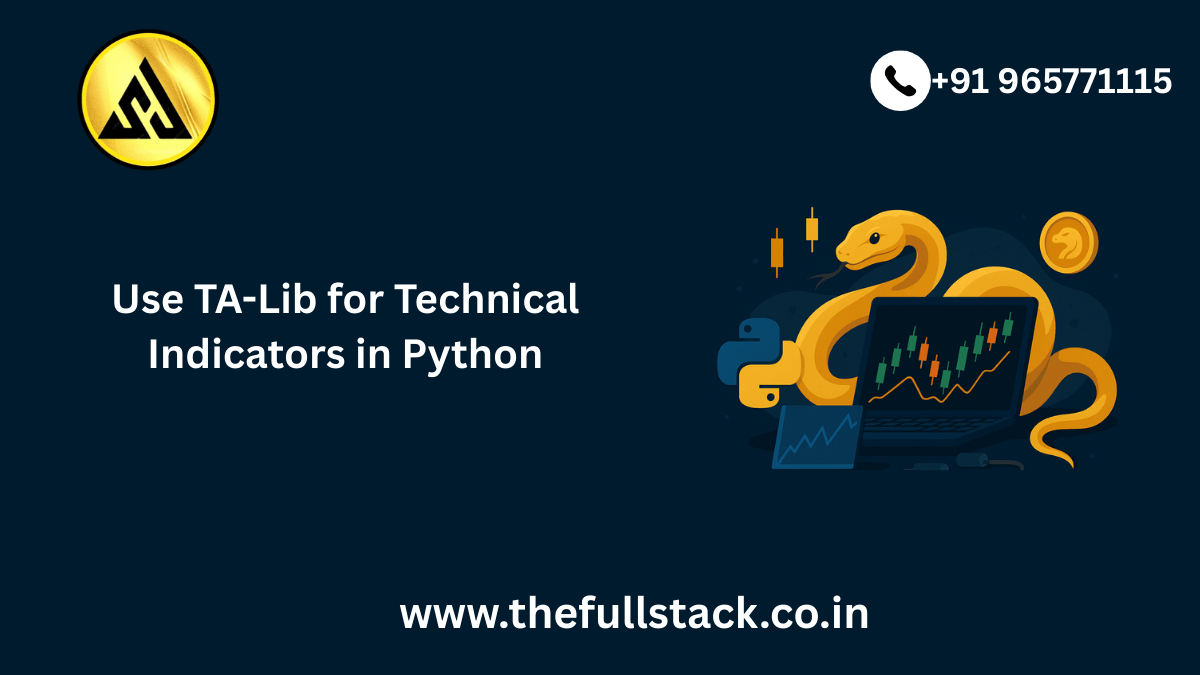
How to Use TA-Lib for Technical Indicators in Python: A Beginner’s Guide
Have you ever wondered how professional traders make data-driven decisions in the stock market? Or how companies manage financial risk by analyzing market trends? The answer often lies in technical indicators—and one powerful tool for calculating them is TA-Lib in Python.
Whether you’re a curious beginner, a team member in a finance-driven company, or someone eager to grow financially, learning how to use TA-Lib is your first step toward smarter investing and long-term financial success.
📈 What Is TA-Lib and Why Should You Care?
TA-Lib (short for Technical Analysis Library) is an open-source library that provides over 150 commonly used technical indicators like RSI, MACD, Moving Averages, and Bollinger Bands. These tools help traders and analysts identify market trends, momentum shifts, and buy/sell opportunities.
Here’s why TA-Lib matters:
- ✅ Speed: It’s built in C++, making it incredibly fast and efficient.
- ✅ Comprehensiveness: Covers a wide range of indicators and mathematical functions.
- ✅ Python-Friendly: Ideal for those familiar with Python and data analysis libraries like Pandas or NumPy.
💡 Why Technical Indicators Matter
Technical indicators aren’t just for Wall Street pros. They’re used by:
- Retail investors tracking personal portfolios
- Financial analysts identifying trends across sectors
- Business teams forecasting demand or risk
- Crypto traders monitoring volatile assets
Let’s say you’re investing in tech stocks. Using TA-Lib, you can apply an RSI (Relative Strength Index) to spot when a stock is overbought or oversold, helping you time your entry or exit more strategically.
🛠️ Getting Started with TA-Lib in Python
Let’s break down the setup and basic usage into manageable steps.
1. Install TA-Lib
TA-Lib can be tricky to install, so follow these steps carefully.
bash
CopyEdit
# On Windows
pip install TA-Lib
# If error occurs, install pre-compiled wheel:
pip install TA_Lib‑0.4.0‑cp39‑cp39‑win_amd64.whl
On macOS or Linux, you might need to install it via Homebrew or compile it from source.
bash
CopyEdit
# macOS (with Homebrew)
brew install ta-lib
pip install TA-Lib
2. Load Your Data
You’ll need historical market data. You can use pandas to load data from a CSV or API.
python
CopyEdit
import pandas as pd
data = pd.read_csv(‘stock_data.csv’) # Include columns like ‘Open’, ‘High’, ‘Low’, ‘Close’, ‘Volume’
3. Apply a Technical Indicator (Example: RSI)
python
CopyEdit
import talib
rsi = talib.RSI(data[‘Close’], timeperiod=14)
data[‘RSI’] = rsi
Boom! You’ve just calculated RSI—one of the most popular momentum indicators.
🔍 Real-World Application Example
Let’s say you work in a fintech startup or a corporate strategy team. Your team is evaluating volatility in the energy sector. You could use TA-Lib’s Bollinger Bands to visualize price movements and alert your risk analysts when the price breaks out of expected ranges.
python
CopyEdit
upper, middle, lower = talib.BBANDS(data[‘Close’], timeperiod=20)
data[‘UpperBand’] = upper
data[‘LowerBand’] = lower
Plot it using Matplotlib for insights your whole team can understand.
🚀 Pro Tips for Beginners
Here are some practical tips to help you start strong:
✔️ Combine Indicators
Don’t rely on a single indicator. Combine RSI with Moving Averages or MACD for more reliable signals.
✔️ Understand the Context
Technical indicators show probabilities, not guarantees. Always combine technicals with market context, news, or industry analysis.
✔️ Backtest Your Strategy
Use libraries like Backtrader or QuantConnect to test your strategy on historical data before going live.
📚 Recommended Indicators to Explore
| Indicator | Use Case |
| RSI | Identify overbought/oversold markets |
| MACD | Spot trend reversals |
| SMA/EMA | Smooth out price data for trend detection |
| Bollinger Bands | Assess volatility and price extremes |
| ADX | Gauge trend strength |
💼 Industry Insights: Why Companies Use TA-Lib
- Risk Management Teams analyze commodity price trends to hedge effectively.
- Trading Desks build algorithmic strategies using real-time indicators.
- Data Scientists in finance departments use TA-Lib to add predictive power to models.
This isn’t just for individual investing—companies are embedding TA-Lib into their analytics stacks.
🎯 Your First Step Toward Financial Literacy
Mastering TA-Lib is more than just learning Python functions. It’s about empowering yourself with tools that give you clarity, strategy, and control over your financial journey.
Whether you’re looking to:
- Improve your investing skills
- Support your company’s analytics efforts
- Pivot into a financial or fintech career
TA-Lib is a fantastic place to start.
👉 Ready to Dive Deeper?
Explore our Advanced Python for Finance Courses and unlock deeper insights into trading algorithms, financial modeling, and machine learning in investing.Let your journey into financial literacy start today—one line of Python code at a time.
What is AWS Lambda?A Beginner’s Guide to Serverless Computing in 2025
Java vs. Kotlin: Which One Should You Learn for Backend Development?


Leave a Reply